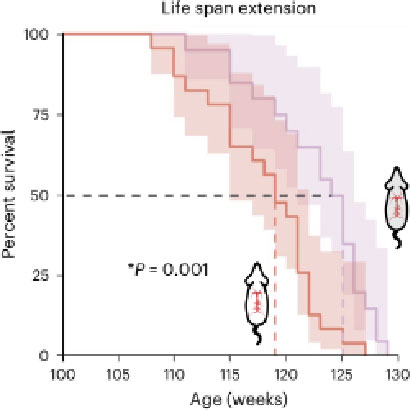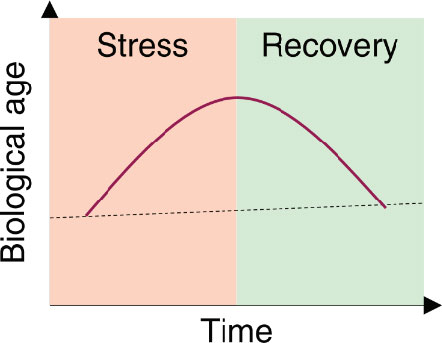Highlights
How old you are (chronological age) and how old your cells and tissues are (biological age) are distinct. Biological age can be measured by using epigenetic biomarkers of aging.
These researchers used epigenetic biomarkers of aging to better understand how biological age changes over time under different conditions. In a series of experiments, the researchers exposed older mice to the blood of younger mice and younger mice to the blood of older mice. They found that the biological age of the older mice decreased, a change that persisted for two months. The biological age of the younger mice increased temporarily before returning to baseline. Additional studies used data from humans to show that biological age in humans temporarily increases during stressful events.
In future work, these researchers are continuing to study the mechanisms of biological aging and develop new epigenetic biomarkers of aging. They hope their research will help improve health outcomes for patients.
How old are you? This is a seemingly simple question. Perhaps you’re a 12-year-old in middle school or an 18-year-old senior in high school or a 70-year-old senior citizen. But the number of years you’ve lived on Earth does not tell the whole story. New research by Dr. Vadim Gladyshev and colleagues at Harvard Medical School shows that biological age is flexible—and more than just a number.
Chronological vs Biological Age
To begin, it is important to define the terms we will use to discuss this research. There is no single definition of aging that all researchers use. In daily life, aging commonly refers to a decline in functions such as memory and mobility. For Dr. Gladyshev, aging refers to molecular damage that occurs over time. “Eventually this damage can lead to diseases and death,” Dr. Gladyshev commented, “but an increase in molecular damage can be measured long before any traditional signs of aging appear.”
According to Dr. Gladyshev, we are all in the process of aging from very early in development, even before we are born. This is because the biological and chemical processes that keep us alive are not 100% perfect. They have negative consequences that lead to molecular damage and, eventually, death. “This is why aging research applies to everyone, not just older people,” added Dr. Gladyshev.
There is a difference between
chronological
and biological age. When someone asks, “how old are you,” the question is referring to chronological age, or how many years you have been alive. While often correlated with chronological age, biological age is the age of your body’s cells, tissues, and organs. Biological age can vary across cells and tissue types. For example, blood cells live only 120 days on average, whereas neurons in the brain are meant to last your entire lifetime.
Chronological age can sometimes be used as an estimate for biological age. However, biological aging occurs at the cellular level long before the physical changes generally associated with getting older. More precise metrics are needed to better understand these changes. For this reason, aging researchers are beginning to identify
epigenetic
biomarkers of aging that can quantify cellular changes.
Biomarkers of Aging
Broadly speaking, a
biomarker
is any objective measurement of a biological process. Biomarkers are often used to indicate a certain state of disease or health. At a routine medical visit, body temperature, blood pressure, and
body mass index
are some examples of biomarkers. In the field of aging, one important type of biomarker is epigenetic changes.
Epigenetic changes occur when genetic expression is altered without affecting the underlying genetic code. There are several ways this can happen, including
DNA methylation.
DNA methylation involves the addition of a methyl group (one carbon and three hydrogen atoms) to specific areas of a genetic sequence.
As we age, the methylation patterns of our DNA change. Some areas increase in methylation and others decrease. One way to quantify the amount of aging a tissue has undergone is to measure ratios of DNA methylation. Epigenetic biomarkers of aging use computer programs to analyze large sets of methylation data from different sites on the
genome
and correlate the result with a specific age.
Some epigenetic biomarkers of aging are specific to certain organs; others can be applied to multiple organs and even across multiple species. Aging researchers have developed a multitude of epigenetic biomarkers of aging that are used in ongoing research into aging processes and a variety of disease states.
It is important to note that researchers still do not understand exactly what epigenetic biomarkers of aging are measuring, even when they are accurate. They can also sometimes produce conflicting or contradictory results. Still, Dr. Gladyshev believes they are a useful tool for improving our understanding of aging, measuring how various factors affect the rate of aging, and ultimately helping us live longer, healthier lives.
Making Older Mice Younger
With the development of epigenetic biomarkers of aging, Dr. Gladyshev and his team can explore how biological age changes over time under different conditions. In a recent set of experiments, Dr. Bohan Zhang and Dr. Jesse Poganik investigated how older (age 20 months) and younger (age 3 months) mice respond when exposed to each other’s circulating blood.
In these experiments, the researchers measured biological age using eight different epigenetic biomarkers of aging. The biomarkers analyzed data collected from the blood and liver of the mice during exposure and up to two months afterwards.
Dr. Zhang looked at older animals who were exposed to the circulating blood of younger mice for three months. While still exposed to the younger blood, the biological age of the older mice decreased. This change persisted for two months after exposure, although the effect was less strong. The researchers found that the mice involved in the experiments lived several weeks longer than control mice. All the epigenetic biomarkers of aging the researchers used for analysis showed similar results. “This demonstrates the strong effects of exposure to young blood on different aging pathways,” commented Dr. Zhang.

Figure 1. Older mice exposed to the blood of younger mice (grey) lived longer than older mice who were not exposed (white).
[Source: Zhang et al 2023, Fig 1c]
The researchers are still trying to understand the mechanisms causing the observed longevity in the experimental mice. One possibility is that factors in the blood of the younger mice decrease the biological age of the older mice. Another possibility is that the blood of the younger mice dilutes toxins and other damaging molecules that might be circulating in the older mice. More research is needed to better understand these processes.
Making Younger Mice Older
Dr. Poganik looked at younger animals who were exposed to the circulating blood of older mice. After three months of exposure to older blood, the biological age in these younger animals increased. However, this elevated biological age went back to baseline once the exposure stopped. “This showed that younger animals were able to deal with temporarily elevated biological age,” Dr. Poganik commented.
To investigate whether biological age might also temporarily increase in humans, Dr. Poganik looked at three events known to be highly stressful on the body: major surgery, pregnancy, and severe COVID-19.
- Major Surgery: Dr. Poganik and colleagues examined blood samples of older patients undergoing major surgery. The researchers observed a rapid increase in biological age in the first 24 hours after surgery, which returned to baseline by 4-7 days after surgery. However, this was only true in patients receiving emergency surgery. Patients who scheduled surgery for an ongoing problem in advance (called
elective surgery)
did not show an increase in biological age. Overall, the patients who received emergency surgery were biologically older than the relatively healthier patients who received elective surgery. These results potentially speak to the increased stress of emergency versus elective surgery.
- Pregnancy: Dr. Poganik analyzed several datasets that included blood samples from pregnant people over the course of their pregnancy. The results showed an increase in biological age between the first and third trimesters of pregnancy that decreased back to baseline by six weeks after pregnancy.
- COVID-19: Dr. Poganik analyzed blood samples from patients who were hospitalized in the intensive care unit due to COVID-19 infection and subsequently recovered. The data were analyzed by sex because of known differences in outcomes of COVID-19 infection in males and females. Overall, the researchers concluded that COVID-19 infection can increase biological age. The results varied based on sex and the epigenetic biomarker of aging used for analysis.
In all three cases, the researchers found that biological age increased during the stressful event and then went back to baseline over time.

Figure 2. Biological age temporarily increases during stressful events and then decreases.
[Source: Poganik et al 2023, Graphical abstract]
In ongoing research, Dr. Poganik and colleagues are hoping to better understand this trend of temporarily increased biological age. “We know that, on average, biological age increases and then decreases,” explained Dr. Poganik. “Within that average, there are people whose biological age increases more than others, and those whose biological age does not reverse to the same extent.” The researchers are planning to explore whether trends in changes in biological age correlate with health outcomes in patients.
Additional Research
Ongoing research projects in Dr. Gladyshev’s laboratory include the development of novel epigenetic biomarkers of aging. Kseniya Melyukhina, administrative assistant in Dr. Gladyshev’s laboratory, described her research into developing an epigenetic biomarker of aging specific for muscle tissue. In this project, volunteers complete weight training on one side of the body, and researchers take samples from muscle tissue on both sides. “By comparing the methylation data between the trained and untrained sides of the body, we can see the effects of training on muscle tissue,” explained Kseniya.
“No matter your age, we are all experiencing aging,” concluded Dr. Gladyshev. “Come join us in the pursuit of science.”
Dr. Vadim Gladyshev is Professor of Medicine at Harvard Medical School and Director of the Center for Redox Medicine at Brigham and Women’s Hospital. His research aims to identify the molecular mechanisms behind aging processes. Ultimately, he hopes his research will lead to new treatments to treat and prevent aging and age-related diseases. Dr. Gladyshev enjoys all aspects of his research, including the opportunities to travel and meet colleagues all over the world. When not in the laboratory or discussing his research, Dr. Gladyshev enjoys playing chess.
Dr. Jesse Poganik is a senior member of Dr. Gladyshev’s laboratory and an Instructor in Medicine at Harvard Medical School. His current research focuses on changes in biological age over time. When not in the laboratory, Dr. Poganik enjoys spending time with his family, including his two cats and two dogs.
Dr. Bohan Zhang is a postdoctoral researcher in Dr. Gladyshev’s laboratory. His current research focuses on approaches to make people younger and live longer. When not in the laboratory, Dr. Zhang enjoys traveling.
Kseniya Melyukhina is an administrative assistant in Dr. Gladyshev’s laboratory who is also involved in several research projects. In a previous career, Kseniya was a professional ballerina. When not in the laboratory, Kseniya enjoys practicing and teaching ballet. She is also learning to play the piano.
For More Information:
- Zhang et al. 2023. “Multi-omic rejuvenation and lifespan extension on exposure to youthful circulation.” Nature Aging, 3: 948-64. https://www.nature.com/articles/s43587-023-00451-9
- Poganik et al. 2023. “Biological age is increased by stress and restored upon recovery.” Cell Metabolism, 35(5): P807-20. https://www.cell.com/cell-metabolism/fulltext/S1550-4131(23)00093-1
To Learn More:
- Gladyshev Lab. https://gladyshevlab.bwh.harvard.edu/
- “Extending lives of old mice by connecting vessels to young ones.” https://news.harvard.edu/gazette/story/2023/08/blood-of-young-mice-extends-lives-of-old-mice
- “The promising weirdness of biological age.” https://news.harvard.edu/gazette/story/2023/04/how-dynamic-is-biological-age/
- World Health Organization. https://www.who.int/news-room/fact-sheets/detail/ageing-and-health
- National Institute on Aging. https://www.nia.nih.gov/
- National Human Genome Research Institute. https://www.genome.gov/genetics-glossary/Epigenetics
Written by Rebecca Kranz with Andrea Gwosdow, PhD at www.gwosdow.com
HOME | ABOUT | ARCHIVES | TEACHERS | LINKS | CONTACT
All content on this site is © Massachusetts
Society for Medical Research or others. Please read our copyright
statement — it is important. |

